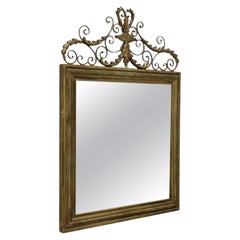Valonia Mirror
Recent Sales
21st Century and Contemporary Asian Rococo Wall Mirrors
Metal
A Close Look at rococo Furniture
Rococo was an aesthetic movement in the fine and decorative arts in the 18th century that found its inspiration in nature and fostered an overall lightness and delicacy of form, construction and ornament in interior design. Rococo furniture, while greatly influenced by trends in Italy and Germany, is often called Louis XV style — the movement having reached its best expression during that sybaritic French king’s reign.
The term “rococo” is thought to be a portmanteau of the French words rocaille and coquilles — “rock” and “shells” — organic motifs frequently used in architecture and design of the style.
When it comes to authentic Rococo furniture's characteristics, it is above all sensuous and social. The furniture of earlier eras in Europe had been heavy in every sense; the Rococo period saw the appearance of light-framed upholstered armchairs, side chairs and occasional tables that could easily be moved to form conversational circles.
The signal detail of Rococo furniture design is the gently curved cabriole, or S-shaped chair-, table-, and cabinet-leg. It imitates the bend of a tree limb or a flower stem. In a further reference to nature, furnishings were often asymmetrical and painted white, or in soft, pastel shades. Rococo has become a timeless style, and as the furniture pieces presented on 1stDibs demonstrate, its playful, sculptural forms can provide visual excitement to contemporary, clean-lined spaces.
Finding the Right mantel-mirrors-fireplace-mirrors for You
Antique and vintage fireplace mirrors and mantel mirrors are sophisticated, classic pieces of decor, with the large size of fireplace mirrors making them centerpiece objects. They add character to any room and also create the appearance of space. Fireplace mirrors and mantel mirrors, like any well-placed antique or vintage mirror, can act as a source of light and make a room seem bigger than it is.
Fireplace mirrors were once a status symbol, as only the wealthiest could afford these big, beautiful pieces for their homes. In the 1500s and 1600s, the Venetian glass industry produced mirrors that were luxury items. Their painstaking creation was the result of a secretive process using melted tin, limiting their size and availability.
In the late 17th century, French glassmaker Bernard Perrot radically transformed mirrors. By casting glass into large, flat slabs, his work grew into an international market for mantel mirrors. These mirrors were often set in decorated frames.
French homes transitioned to lower fireplaces and mantels so tall mantel mirrors could fit above them. The design of fireplace mirrors reflected architectural trends. Some in the mid-18th century featured paintings, while others had delicate carvings.
By the 1800s, mantel mirrors had become more widely available. This reflected a dramatic change in glass mass-production technology, which made oversize mirrors more accessible, leading to their proliferation across the globe.
Today, mantel mirrors are still highly regarded statement pieces with an enduring reputation for elegance. Their versatility has allowed them to branch out beyond the fireplace. Their reflectiveness allows them to amplify a sumptuous painting in a bedroom or capture the tiling of a bathroom.
From mid-century modern designs to pieces created in Louis XVI style, there is a mirror for every room and every occasion on 1stDibs.
